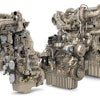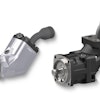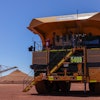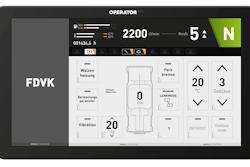
This article is sponsored by STW Technic, LP.
The human-machine relationship is multifaceted and complex. But the interaction doesn’t have to be. If there’s one thing that equipment engineers, product developers, managers, owners and operators have learned in the past decade it’s that the human machine interface (HMI) display is the gateway to — and often the determinant of — a successful interaction.
No display, no interaction. No interaction, no relationship. But what defines a great display? And where does the display fit into the overall needs of the equipment — and its user?
At its simplest, the HMI display is the bridge between the physical representation and the movement of the machine, and what the operator wants it to do. A look into the last century of display technology history can provide a roadmap for the future of what those operators will experience and help guide our predictions.
A Brief History of Display Technology1930s — Cathode-ray tube (CRT) 1960s — Vacuum fluorescent display (VFD) 1980s — Super-twisted nematic (STN), early liquid crystal display (LCD) 1970s — Thin-film transistors (TFT), a type of LCD 2000s+ — Microscopic light-emitting diodes (MicroLED) and next-generation TFT |
Prediction 1: HMI displays will be an OEM mainstay — and consumers are to thank.
CRTs were first used in the manufacture of TV sets starting in 1934 and rapidly gained traction. Thirty years later, 93% of U.S. homes had a TV set. It would be another 20 years before heavy equipment machinery used CRTs to present data and controls. Albeit bulky and slow, the technology was used by equipment manufacturers because of its ubiquity in homes. That consumer experience can offset almost any go-to-market challenge, says Kyle Boch, senior applications engineer at STW Technic, the leader in the design, manufacture and implementation of electronic solutions for off-highway vehicles.
“In the mobile machine market, adoption of new technologies is almost always tied to how mature and robust the technology is,” he explains. “Once proven on a much larger scale like the consumer market — and as long as it is rugged — is almost a guarantee that it will soon be embraced.”
What’s happening in homes today affects heavy equipment design a decade from now. Look no further than the internet-connected appliances in a modern kitchen or the 97% of Americans who own a mobile phone: bright, high-contrast LED screens are built into everything.
Prediction 2: The automotive industry will take the lead.
The squeaky wheel gets the grease, and that wheel belongs to the automotive market. Production numbers dictate attention and automakers — and their suppliers — are focused on keeping retail channels stocked with the latest and greatest, followed by fleet vehicles, which make up about 20% of their market.
After automotive, Boch points to the agricultural equipment industry as making technological advancements with the early majority. Boch himself experienced it firsthand as the son of a farmer with a technology that was seen in the auto and ag markets almost simultaneously.
“When auto-steer systems were first introduced, the bar for the level of technology on agriculture equipment was raised significantly. After this improvement, others were expected,” said Boch. “We wanted more advanced HMIs that could combine the functionality of a bunch of displays into one. We wanted the removal of switch banks that offered no feedback or troubleshooting ability. These eventual improvements made our experience so much better.”
The same TFT-LCD displays that accompanied lane centering and related tech for cars made their way to ag equipment. So we can reasonably expect the HMI features that drivers love will find a home on your machine — and a prominent place on the display — in your heavy equipment.
Prediction 3: What sells in off-highway equipment won’t be the most bleeding-edge — it will be what’s most reliable.
What works for heavy equipment operators is mature technology that’s been through the paces. What that looks like may change by the user — but in general that means display tech that is resistant to heat and cold extremes, functional with dirt and dust, and so robust that they have virtually no downtime.
Operators today still get what they need from the TFT displays of the past decade, and engineers don’t blame them, Boch explains.
“It still holds its own in terms of power requirements. What will drive a shift in development is a desire to utilize less resources — less computing power, less manufacturing requirements, in terms of layering all the different substrates that's required for TFT displays — and gaining more efficiency,” Boch predicts.
Prediction 4: OEMs and operators alike will demand performance improvements.
The move most engineers, including Boch, predict will occur is the shift to microLED displays, which can last hundreds of thousands of hours. Right now, it’s not a technology that is mass marketed; instead you might see it on enormous display screens (think 200+ inches) at major events. As machine designs progress and when the time is right, operators and OEMs will both be pivotal in pushing for display technology to move to microLED.
Echoing history, early monochrome or tricolor LCD screens, which used STN technology, made their way into equipment in the 1990s — a little after winning fans in systems like the Nintendo Gameboy. Boch has a distinct memory of his first interaction with early LCD tech on his farm.
“It felt incredible on its 1-minute boot up time. And the laggy display, the first touch screen we had, was just terrible, but I think that was a pretty big step on our farm, especially when going from the analog to that touch screen,” Boch recalls. “It happened in one machine generation, moving from gauges to LCD.”
Prediction 5: Some technology will take off, some won’t.
As automakers roll out 20- and 30-inch screens, microLED makes more sense. It offers better contrast, pixel-level light control, and a long lifespan. The evolution of LED has already led to innovations like STW Technic’s inSIGHT Mobile Machine Displays, which offer a 170-degree viewing angle and a backlight level of 100 nits for optimum visibility.
VFDs were developed in the 1960s as CRTs took off and had an advantage as a low-light display option of choice for calculators and other data devices. But it remained the lesser-used alternative to CRTs. In 2024, the tech face-off will be microLEDs versus next generation TFTs.
“I think the TFT displays could do the job that they need to do for the next 100 years if we wanted them to,” Boch posits — but do we want them to?
On the consumer side, compare it to the HD-DVD versus Blu-ray market battle of 15 years ago. When Blu-ray came out, nobody needed 4k resolution — but everyone wanted it. Development followed demand. With that as a guide, microLED will be the winner, and Boch sees it taking off in the next 5 to10 years — but a decade-plus for the construction industry.
Prediction 6: The winner will be microLED — and electrohydraulics will be the deciding factor.
HMI display success comes down to three characteristics, Boch says: The display must be seamless, intuitive and have the fewest steps. That’s what happened in the past decade as positioning systems and precision construction technology took off and telematics integrations for remote and autonomous operations gained traction.
The next revolution will come as electrohydraulic and alternative power sources hit critical mass and the HMI changes yet again. MicroLED has an advantage as OEMs change to new drive systems.
“It might not be electrically more efficient, but in terms of manufacturing and system design, it is a much more efficient technology,” Boch says.
An HMI display is the easiest way to show your customer value. Boch and the team at STW Technic are working to empower the mobile machines of tomorrow and proactively answer questions about where the market is going. As Boch says: “We’re here to make software development not so scary.” That means offering products but also service-based solutions. STW Technic is bridging the gap between the technology and the machine, the machine and the operator, and leading the charge for the HMI displays of the future. To learn more, visit stw-technic.com/insight.


















